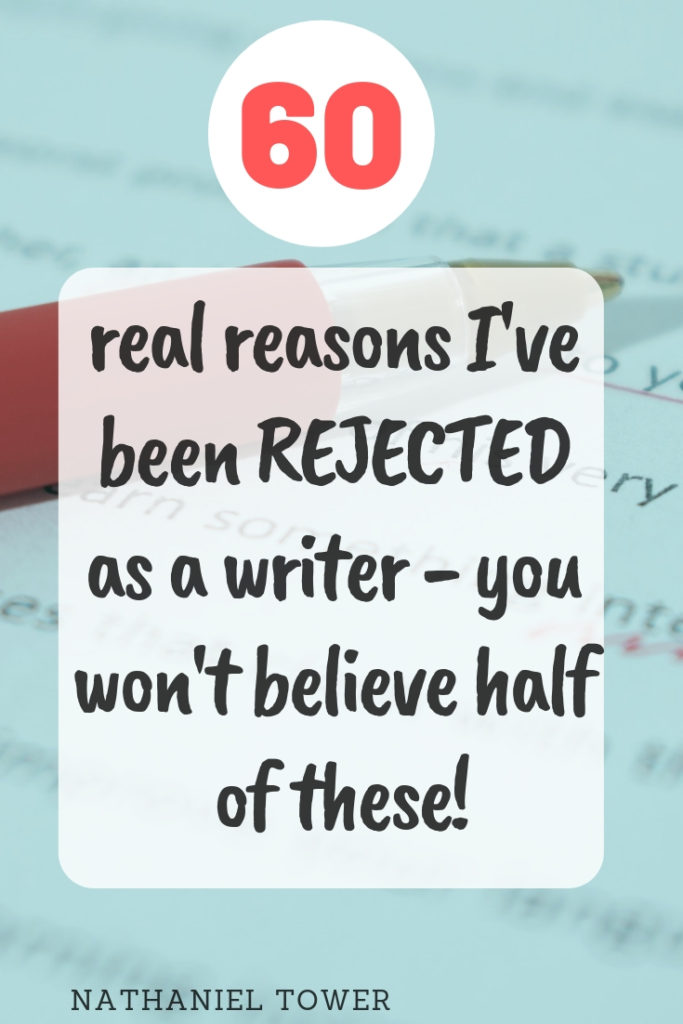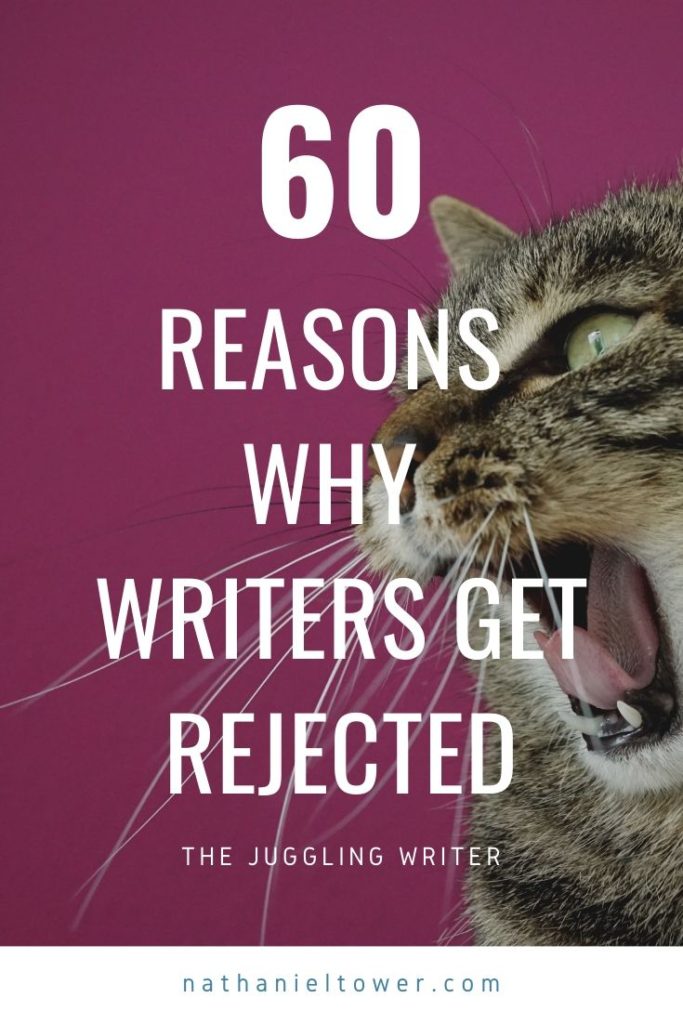Last Updated on July 8, 2023 by Nathaniel Tower
So, you’ve written a story. What now? Well, must be time to submit it for publication, right? Before you do, stop and think about whether this story is really ready to be accepted.
What makes me an expert on this topic? Over the past 15 years, I’ve submitted my work over 1,500 times. This has led to over 300 publications, but it’s also led to almost 1,000 rejection letters. I’ve also had the painful duty of rejecting thousands of stories through my own literary magazine.
Here are some things I’ve learned about rejection (as both an editor and a writer)
Note: The following list reflects some actual reasons I’ve had stories rejected as well as reasons I’ve rejected stories. Other reasons are completely fabricated, but still possibly true. Astute readers will recognize that some of these things are trivial reasons for rejection.
1. Submit a first draft
2. Write about vampires. Especially sexy teen vampires.
3. Submit a story you never even proofread
4. Submit to a publisher without reading anything about that publisher
5. Submit something that goes way over the publisher’s word limit
6. Submit in some unappealing format, like a really big typeset or maybe one of those cursive fonts
7. Submit via mass email to a lot of publishers. Don’t bother blind copying the publishers. Let everyone know who you are submitting this story to.
8. Offer a list of demands to a publisher
9. Flagrantly write something the publisher doesn’t want to see and mention that you know the publisher doesn’t want to see it but that it’s really good
10. Write stories about child abuse that don’t have happy endings
11. Write stories about child abuse
12. Use nothing but clichés
13. Address your cover letter to a different magazine
14. Talk about how bad your story is in the cover letter
15. Talk about how great your story is in the cover letter
16. Resubmit a story when the publisher clearly doesn’t want to see it again
17. After being told to wait a week to submit another piece, submit another piece an hour later
18. Send previously published work to places that don’t accept previously published work. Be sure to mention that it was previously published
19. Send plagiarized work
20. Send your story in the wrong format, with the wrong margins, the wrong headings, etc.
21. Send the wrong story
22. Put contact info on your story when the publisher requests no contact info
23. Don’t put contact info on your story when the publisher requests contact info
24. Say in your cover letter that this story is better than stories the publisher released in the last issue
25. Write stories in which nothing happens
26. Write stories with lots of POV shifts
27. Submit a blank piece of paper and claim it is experimental
28. Submit an attachment to a publisher who doesn’t want attachments
29. Put “best story ever” in the subject line
30. Don’t put anything in the subject line
31. Admit that you’ve never read the magazine in the cover letter
32. Don’t include a cover letter
33. Include too much in a cover letter
34. Fill the story with pointless profanity (and don’t forget to follow up the rejection email with a profanity-filled email of your own)
35. Criticize the publisher’s taste after a rejection and then submit another story
36. Use margins that are too big
37. Use margins that are too small
38. Triple space
39. Double space
40. Single space
41. Add an extra space between periods
42. Don’t add any space between periods
43. Mention in your cover letter that the publisher will need to make some edits
44. Submit a story where everyone dies in the end
45. Ask for money from a non-paying publisher
46. Ask for more money from a paying publisher
47. Submit to The New Yorker
48. Use page numbers
49. Don’t use page numbers
50. Be too experimental
51. Don’t be experimental enough
52. Be too weird
53. Don’t be weird enough
54. Accuse the editor of being sexist
55. Submit a story about the exact same thing that was just published in the magazine
56. Submit multiple stories to a publisher who doesn’t want multiple submissions
57. Submit an unfinished story and say you’ll finish it if the editor likes the beginning
58. Submit when a publisher isn’t open to submissions
59. Submit an unagented submission to a place that only accepts agented subs.
60. Submit anything at all. To anywhere. Chances are, it’ll get rejected.
Disclaimer: Following all of these guidelines will not necessarily guarantee acceptance or rejection. Results may vary. Consult your agent.




Found this both informative and funny. Another one is ‘get the editor’s name right’. One’s name is the most important two words to anyone.
I’m not an editor however in general correspondence I get annoyed at anything addressed to “Mr Stuart”. Since I don’t know him, the e-mail/letter is unlikely to get any response from me.
I know just how you feel, David. I’ve seen a lot of submissions addressed to Mr. Towers. I always respond though. Honestly, I try not to let little things affect my decision as an editor. If I like a story enough to publish it, the cover letter isn’t likely to change my mind. I typically don’t even look at a cover letter until I’m about to respond to the submission. Sometimes I never look at it. The most important thing to me is the quality of the story. But things like that can certainly never help.
Great post. It’s comforting to see an editor who doesn’t base their entire opinion on the cover letter, but I’d be interested to know what you think would make a “good” cover letter? Apologies if you’ve already covered this.
Catherine, thanks for commenting. I think cover letters are an interesting thing in the writing business. Obviously, the story should do the talking, but I don’t think that means cover letters are useless. If we’re talking about a publisher who receives thousands of submissions a day, a cover letter might be a necessity in the selection process. But for me, and probably most smaller presses, the cover letter takes a backseat to the actual story. Can a good cover letter make a difference? I think it might make me more excited to read a subsequent submission from that same author. It also sometimes makes rejection tougher. But after reading a story, I’m not going to suddenly decide to accept it because of the cover letter. That doesn’t mean I don’t appreciate a good cover letter. I like seeing authors who really care about their work and the venue they are submitting to. No matter how much I like a submitter though, I have to like the story, and a cover letter isn’t going to make me like it.
What a hilariously great list, thanks for the insight Nate!
Loved these, ha ha
50. Be too experimental
51. Don’t be experimental enough
52. Be too weird
53. Don’t be weird enough
60. Submit anything at all. To anywhere. Chances are, it’ll get rejected.
Just out of interest, when you say not to submit anything about child abuse, are you referring solely to short-story subs, or submissions in general. I ask this mainly because my guilty pleasure is crime fiction. It’s my go-to genre for escapism, relaxing reading and quick, on-the-go fiction that I can pick up and put down throughout the day (on lunch-breaks, on bus etc). Some of the best, most engaging books I have read have included aspects of child abuse. Not because I’m weirdly sick in the head, but because the stakes always seem higher when the victims/potential victims are more vulnerable. A perfect example of a book which breaks two of your rules (features child abuse and a dead baby) is ‘Kisscut’ by Karin Slaughter, which is my favourite book of hers. I know that it’s not the first book in her Grant County series and she was already an established author, so maybe that is a factor in granting her a special dispensation for writing a book that was so heavily oriented towards these big ‘no-no’ subjects, but does that mean that your rule applies mainly to newer submissions by unknown authors, or just a rule of thumb that you think should apply to everyone? Kind regards, Bex.
Hi Bex, thanks for reading and commenting. Great question! I don’t think you should never write child abuse, but it’s definitely a topic that will make some editors squeamish and lead to instant rejection. But a really good writer can tackle any topic and make it publishable and engaging. You just have to be careful and make sure your story/submission doesn’t seem like it could be advocating child abuse. You also don’t want to simply be using it as a plot mechanism. It has to be something much more than that. I haven’t read that particular book (I’ll have to add it to my reading list). I’m sure it serves as a good example for how you can write those tough topics. Hope that helps!
Brilliant! Noted and understood!
Wow, that’s quite an extensive list of reasons why writing might be rejected. It seems like the author has gathered these reasons based on their own experiences as both a writer and an editor. It’s interesting to see the different aspects of writing and submitting work that can lead to rejection, ranging from simple mistakes like submitting a first draft or not proofreading, to more specific reasons like not following submission guidelines or writing about controversial topics. It’s a good reminder for writers to carefully consider their work and make sure it’s polished and tailored to the specific publisher they’re submitting to.
https://givevaluefirst.com/10-proven-ways-to-boost-your-online-income/